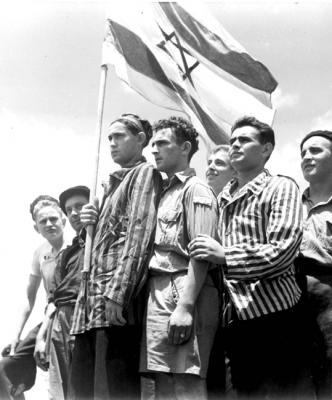At the end of World War II, thousands of Jews who had survived Nazi persecution attempted to reach the shores of this country. Many were thwarted by the British, and interned once again behind barbed wire. Others were more successful: slipping in under cover of darkness, to become an inseparable part of the Jewish community in Eretz Israel (Mandatory Palestine). But six decades ago, the doors of the country were finally flung open and hundreds of thousands of Holocaust survivors streamed in. As Israel celebrates its 60th anniversary, its population of Holocaust survivors finds itself once again in the spotlight. Passionate discussions of the government¹s treatment of and attitude towards the survivors, together with a global and national reawakening of interest in the Holocaust, have only fueled this topic.
But an often overlooked-and seldom told-aspect of the Holocaust survivors¹ story is the incredible tale of their arrival in Eretz Israel and the pivotal role they played in creating the country we see around us today. In the history of immigration, there has been no comparable story to that of the survivors who made Aliyah. Rarely, if at all, has a group of immigrants made so profound an impact on a society, and so fully participated in charting its course.
Hundreds of thousands of Jews came to Eretz Israel prior to World War II as part of the modern Zionist movement that began in late 19th century, renewing efforts to build the Jewish community in Eretz Israel and settle the land. After the Holocaust, survivors left the camps, and emerged from hiding and from the forests, and first attempted to make their way to the towns and cities across Europe from which they had been deported. Most did not stay long. Yet, during those anguished days of liberation, as many realized they had emerged from the inferno alone, the survivors made an astonishing choice: they chose life.
Many chose to come to Eretz Israel. On arrival, they did not ask for a moment of recuperation or peace, but set about rebuilding their lives anew. Many volunteered to fight for their new country, in the IDF Gachal program and other frameworks, and among those who fell in battle were the last remnants of entire families. The survivors¹ first encounter with life in thier new country was far from easy. But they did not lose strength or the desire to live. They took nothing for granted, and with little help, they began from scratch. Building towns and kibbutzim, schools and yeshivot, creating new businesses and opening new cultural vistas, the survivors exhibited a creativity and energy that continues to astonish us today. Clinging to their Jewish identity, they quickly became active partners in the most important communal endeavor of the Jewish people of the 20th century-the establishment and development of the State of Israel.
Some did not manage to rehabilitate their shattered lives. But most survivors found a core of inner strength that is hard for us to comprehend. Their dramatic story in this land is one of personal victory and the triumph of the human spirit, and is the subject of a temporary exhibition at Yad Vashem: My Homeland: Holocaust Survivors in Israel (2008).
Alongside building their new lives, the survivors were committed to commemoration: remembering their own families, their communities and each one of the six million Holocaust victims. They told stories of heroism, of the sanctification of life in the ghettos and camps, and of armed combat. They described the last steps of those who collapsed on the death marches-on the very brink of liberation-and testified to the deeds of the Righteous Among the Nations, a small ray of light amid the great darkness. They commemorated the story of the annihilated in memorial books, monuments and personal memoirs, and today they continue this endeavor by giving public testimony and escorting delegations of students, educators and soldiers to sites in Eastern Europe. Naturally, there are survivors who, in their old age, require our support, particularly among the tens of thousands of new immigrants from the FSU.
Today, having established their lives and merited to see grandchildren and great-grandchildren, the survivors continue to tell-by their very being-the story of their immigration, absorption and their lives in Israel. They did not forget the Holocaust. They did not forget their families and destroyed communities. But from their terrible, inconceivable experiences, they rose with strength and commitment to build a future for themselves and their families. Today, as we look around at the modern state of Israel - in the arts, in national defense, in law, in medicine, in the economy, in religious scholarship, into the very faces of our society- we are indebted to the survivors. They are an inspiration to us all.
Avner Shalev is Chairman of Yad Vashem, and co-editor of We're Here (Hebrew; Yad Vashem Publications 2008), a photographic album documenting the story of Holocaust survivors in Israel.







